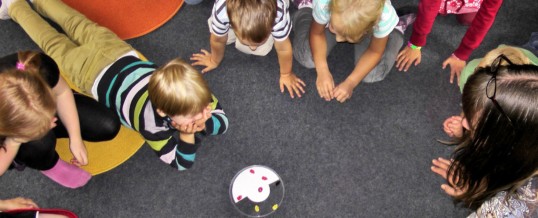
The situation: Mrs. Parker called out to her preschool class, “It’s almost time to clean up and go outside to play.”
It was a cold snowy day and the children needed to put on warm clothes.
Laura looked up and said, “No, I’m not going.” Paul screamed, “I didn’t get my turn on the easel.” Rebecca ignored the direction, and two boys, Jason and Robbie, started running around the room chasing each other.
Mrs. P raised her voice. “It’s time to finish what you are doing and put on your coats!”
William, who was struggling to put on his snow pants, fell backwards, crying that he needed help, while Jennifer teased him that he was a baby to cry about his pants.
Mrs. P’s pleasant, productive classroom had suddenly turned to chaos.
The lesson: As every preschool teacher knows, at any given moment there is a great deal going on in the classroom. Early childhood teachers feel pulled in many directions at once. The most skillful teacher seems to have the ability to attend to the needs and desires of each child. What an amazing skill to have naturally or to acquire.
On this day, the activity that created trouble was to transition to outside play. It was tempting and seemed most efficient to give verbal direction to the whole class. Sometimes early childhood teachers miss the idea that the transition itself – in this case to put on outdoor clothing – can be an activity worthy of note on a lesson plan.
If she had thought about it this way, Mrs. Parker might have given an alert or direction about the transition individually to each student – just as she would when working on any other challenge or skill.
This allows each child an opportunity to respond with anything that might be on the child’s mind – possibly uncovering obstacles to a smooth transition. She might hear, “I need to finish my puzzle,” or “Mrs. P, my coat is hard for me to zip by myself,” or “Oh, I can’t wait to go outside and show you how I can shovel snow!”
Children can listen better and respond more appropriately when they have a connection with the teacher, even a momentary one. This approach takes time, but what a good use of a few minutes in a preschooler’s day.
Learning points
- Look directly at the child as you listen.
- Encourage the child to look at you, rather than demanding it.
- Use a gentle, quiet voice.
- Use an understanding voice.
- Make some physical contact: Hold a hand, touch an arm, offer a hug.
- Model good listening by paying attention to what the child wants to say, even if you do not agree. It always feels respectful.
- Use feeling words with the child.
- Praise the child as much as you can even for doing simple things that are expected, such as hanging up a coat, cleaning up, getting dressed and following rules.
- Smile at the child; it’s contagious!
AUG
2018


About the Author:
Judith L. Pitlick, MA, LPCC is a child, adolescent, and adult psychotherapist and psychoanalyst in private practice in Shaker Heights, Ohio. She works with individuals, couples, parents and families. As a licensed teacher in regular and special education, she previously taught at a therapeutic school as well as at area colleges and universities. She is on the faculty at The Hanna Perkins Center for Child Development, where her work includes consultation with directors, teachers and parents at area schools and child care centers. Pitlick is on the Faculty of the Cleveland Psychoanalytical Center and is a clinical Instructor in the Case Western Reserve Medical School Department of Psychiatry.